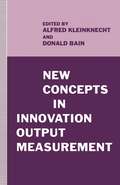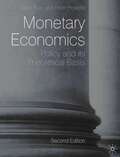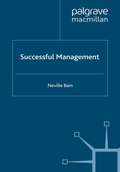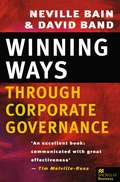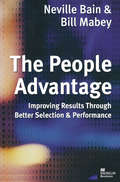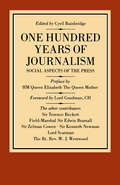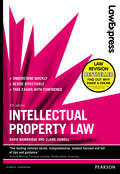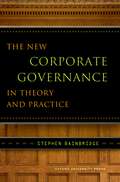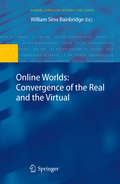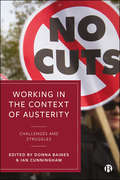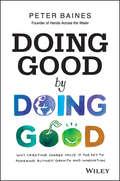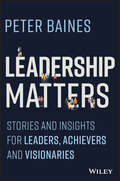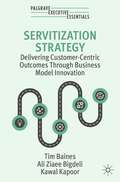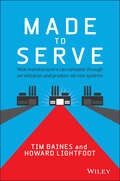- Table View
- List View
New Concepts in Innovation Output Measurement
by Donald Bain A. KleinknechtThis collection of papers describes advances in the measurement of innovation output, principally through the use of a new technique based on scanning of trade and technical journals. Experience in several countries is assessed and the strength and weaknesses of the technique discussed. The conclusion is that, taken together with recent advances in the design of questionnaires for postal surveys of innovation, this technique provides a radically improved data source for testing innovation theories and for effective policy analysis.
Monetary Economics: Policy and its Theoretical Basis
by Keith Bain Peter HowellsThis fully revised second edition of Bain and Howells' Monetary Economics provides an up-to-date examination of monetary policy as it is practised and the theory underlying it. The authors link the conduct of monetary policy to the IS/PC/MR model and extend this further through the addition of a simple model of the banking sector. They demonstrate why monetary policy is central to the management of a modern economy, showing how it might have lasting effects on real variables, and look at how the current economic crisis has weakened the ability of policymakers to influence aggregate demand through the structure of interest rates. The second edition: features a realistic account of the conduct of monetary policy when the money supply is endogenous provides a detailed and up-to-date account of the conduct of monetary policy and links this explicitly to a framework for teaching macroeconomics includes recent changes in money market operations and an examination of the problems posed for monetary policy by the recent financial crisisMonetary Economics is an ideal core textbook for advanced undergraduate modules in monetary economics and monetary theory and policy.
Successful Management
by N. BainThis book provides a guide to successful management. Managers need to set the right objectives for the company and clear objectives for themselves. A general manager must develop new strategies that are relevant to the environment and are based on the core competences of the corporation. These strategies will need to yield a long term competitive advantage so that they significantly increase the value of the company over time. This book, by the Chief Executive of a major multinational company, provides many insights and thoughtful consideration of important aspects of successful management.
Winning Ways through Corporate Governance
by Neville Bain David BandThe motivation for writing this book is the authors' deeply held conviction that good governance is an essential element for any organisation that wishes to maximise its effectiveness. They are not alone in observing that in many cases companies or other organisations that perform badly are often poorly governed. Indeed, the key explanation for poor performance is often poor governance. This observation is not limited geographically and there are many examples from around the world. Concern with good governance is not just limited to the free enterprise system. It is universal.
The People Advantage: Improving Results Through Better Selection and Performance
by Neville Bain Bill MabeyThe main source of competitive advantage for an organisation rests in its people. Many companies claim that its people are the greatest asset of the company, but the evidence is that few behave accordingly. Indeed, when managers are appointed to new important positions, such as their first general management position, few receive any special training for this role. The evidence is that most appointees are appointed on the basis of their track record, and not through any attempt to evaluate the new position and to match the candidate's objectively measured skill base against the core competencies needed for that job. This book demonstrates the many ways that the careful selection of individuals and teams can add value to the enterprise. It also demonstrates that there are methods by which teams can be enhanced through utilising and understanding the diversity of the different styles of the individuals.
Law Express: Intellectual Property Law
by David Bainbridge Claire HowellThe Law Express series is designed to help you revise effectively. This book is your guide to understanding essential concepts, remembering and applying key legislation and making your answers stand out!
The New Corporate Governance in Theory and Practice
by Stephen BainbridgeForty years ago, managerialism dominated corporate governance. In both theory and practice, a team of senior managers ran the corporation with little or no interference from other stakeholders. Shareholders were essentially powerless and typically quiescent. Boards of directors were little more than rubber stamps. Today, the corporate governance landscape looks vastly different. The fall-out from the post-Enron scandal and implementation of the Sarbanes-Oxley Act have resulted in shareholder activism becoming more widespread, while many observers call for even greater empowerment. The notion that the board of directors is a mere pawn of top management is increasingly invalid, and as a result, modern boards of directors typically are smaller than their antecedents, meet more often, are more independent from management, own more stock, and have better access to information. The New Corporate Governance in Theory and Practice offers an interdisciplinary analysis of the emerging board-centered system of corporate governance. It draws on doctrinal legal analysis, behavioral economic insights into how individuals and groups make decisions, the work of new institutional economics on organizational structure, and management studies of corporate governance. Using those tools, Stephen Bainbridge traces the process by which this new corporate governance system emerged, and explores whether such changes are desirable or effective.
Corporate Governance after the Financial Crisis
by Stephen M. BainbridgeThe first decade of the new millennium was bookended by two major economic crises. The bursting of the dotcom bubble and the extended bear market of 2000 to 2002 prompted Congress to pass the Sarbanes-Oxley Act, which was directed at core aspects of corporate governance. At the end of the decade came the bursting of the housing bubble, followed by a severe credit crunch, and the worst economic downturn in decades. In response, Congress passed the Dodd-Frank Act, which changed vast swathes of financial regulation. Among these changes were a number of significant corporate governance reforms. Corporate Governance after the Financial Crisis asks two questions about these changes. First, are they a good idea that will improve corporate governance? Second, what do they tell us about the relative merits of the federal government and the states as sources of corporate governance regulation? Traditionally, corporate law was the province of the states. Today, however, the federal government is increasingly engaged in corporate governance regulation. The changes examined in this work provide a series of case studies in which to explore the question of whether federalization will lead to better outcomes. The author analyzes these changes in the context of corporate governance, executive compensation, corporate fraud and disclosure, shareholder activism, corporate democracy, and declining US capital market competitiveness.
Corporate Governance after the Financial Crisis
by Stephen M. BainbridgeThe first decade of the new millennium was bookended by two major economic crises. The bursting of the dotcom bubble and the extended bear market of 2000 to 2002 prompted Congress to pass the Sarbanes-Oxley Act, which was directed at core aspects of corporate governance. At the end of the decade came the bursting of the housing bubble, followed by a severe credit crunch, and the worst economic downturn in decades. In response, Congress passed the Dodd-Frank Act, which changed vast swathes of financial regulation. Among these changes were a number of significant corporate governance reforms. Corporate Governance after the Financial Crisis asks two questions about these changes. First, are they a good idea that will improve corporate governance? Second, what do they tell us about the relative merits of the federal government and the states as sources of corporate governance regulation? Traditionally, corporate law was the province of the states. Today, however, the federal government is increasingly engaged in corporate governance regulation. The changes examined in this work provide a series of case studies in which to explore the question of whether federalization will lead to better outcomes. The author analyzes these changes in the context of corporate governance, executive compensation, corporate fraud and disclosure, shareholder activism, corporate democracy, and declining US capital market competitiveness.
Managing Nano-Bio-Info-Cogno Innovations: Converging Technologies in Society
by William Sims BainbridgeWith the convergence of Nanotechnology, Biotechnology, Information technology and Cognitive science (NBIC) fields promising to change our competitive, operational, and employment landscape in fundamental ways, we find ourselves on the brink of a new technological and science-driven business revolution. The already emerging reality of convergence is to be found in genomics, robotics, bio-information and artificial intelligence applications, such as: • Self-assembled, self-cleaning and self-healing manufactured materials and textiles, and much stronger, lighter and more customizable structural materials, • Miniature sensors allowing unobtrusive real-time health monitoring and dramatically improved diagnosis; with greatly enhanced real time information to vehicles and drivers on the way, • New generations of supercomputers and efficient energy generators based on biological processes, • Greatly enhanced drug delivery from unprecedented control over fundamental structural properties and biocompatibility of materials. These advances are here already, or in development. And Japan, other Asian nations and Western European countries are investing heavily and moving aggressively to develop and apply NBIC technologies. Notwithstanding the passage of the 21st Century Nanotechnology Research and Development Act, significant further funding and action by both government and private industry will be critical to maintaining US scientific and industry leadership.
Online Worlds: Convergence Of The Real And The Virtual (Human–Computer Interaction Series)
by William Sims BainbridgeWilliam Sims Bainbridge Virtual worlds are persistent online computer-generated environments where people can interact, whether for work or play, in a manner comparable to the real world. The most prominent current example is World of Warcraft (Corneliussen and Rettberg 2008), a massively multiplayer online game with 11 million s- scribers. Some other virtual worlds, notably Second Life (Rymaszewski et al. 2007), are not games at all, but Internet-based collaboration contexts in which people can create virtual objects, simulated architecture, and working groups. Although interest in virtual worlds has been growing for at least a dozen years, only today it is possible to bring together an international team of highly acc- plished authors to examine them with both care and excitement, employing a range of theories and methodologies to discover the principles that are making virtual worlds increasingly popular and may in future establish them as a major sector of human-centered computing.
Working in the Context of Austerity: Challenges and Struggles
by Donna Baines Ian CunninghamAusterity was presented as the antidote to sluggish economies, but it has had far-reaching effects on jobs and employment conditions. With an international team of editors and authors from Europe, North America and Australia, this illuminating collection goes beyond a sole focus on public sector work and uniquely covers the impact of austerity on work across the private, public and voluntary spheres. Drawing on a range of perspectives, the book engages with the major debates surrounding austerity and neoliberalism, providing grounded analysis of the everyday experience of work and employment.
Marketing: (pdf)
by Paul Baines Paolo Antonetti Sara RosengrenHow does Google support organizations in their transformation to digital marketing? How does the International Food Waste Coalition influence more sustainable behaviour? How did a producer of Thai herbal toothpaste amend their marketing mix to maintain sales during COVID-19? With insights from leading practitioners and exploration of the latest issues to affect consumers and businesses alike, Marketing answers these questions and more to provide students with the skills they need to successfully engage with marketing across all areas of society. Founded on rigorous research, this critical text presents a current, complete guide to marketing success and explores topical issues such as sustainability and digital transformation. Its broadest ever range of examples, Practitioner Insights and Market Insights also give readers a unique view into the fascinating worlds of marketing professionals. Individuals from Arch Creative, Klarna, eDreams Odigeo and Watson Farley & Williams are just a few of the practitioners that join the authors to offer real-life insights and career advice to those starting out in the industry. Review and discussion questions conclude each chapter, prompting readers to examine the themes discussed in more detail, and encouraging them to engage critically with the theory. New critical thinking questions also accompany the links to seminal papers throughout each chapter, presenting the opportunity for students to take their learning further. An exciting development for this new edition, the enhanced e-book offers an even more flexible and engaging way to learn. It features a select range of embedded, digital resources designed to stimulate, assess, and consolidate learning, including practitioner videos to offer further glimpses into the professional world, multiple-choice questions after each key section of the chapter to offer regular revison and understanding checkpoints, and a flashcard glossary at the end of each chapter to test retention of key terms and concepts. Marketing is the complete package for any introductory marketing module. This book is accompanied by the following online resources. For everyone: Bank of case studies Practitioner insight videos Career insight videos Library of video links For students: Key concept videos Author audio podcasts Multiple-choice questions Flashcard glossary Internet activities Research insights Web links For lecturers: PowerPoint slides Test bank Essay questions Tutorial activities Discussion question pointers Figures and tables from the book
Public Relations
by Paul Baines John Egan Frank JefkinsPublic Relations: contemporary issues and techniques offers a definitive guide to public relations management. It provides comprehensive analysis and explanation of a full range of modern PR techniques, spanning both inhouse and agency practice.The text has involved fundamental restructuring and updating of existing material and the incorporation of the new techniques and strategies, for instance:* The use of multimedia techniques in PR* Overseas media and the globalization of media communications* The latest case examples - notably New Labour's rebranding and media management since 1997, government PR during the 2001 war against Afghanistan, and the 2002 football World CupThe book presents the core strategies for successful PR combining this with indepth advice on implementation and the everyday techniques that every PR person needs to grasp. With a range of new user-friendly textual features, the book's practical, how-to focus, wedded to firm theoretical analysis, makes it the ideal text for those studying for professionally accredited examinations such as the IPR, CAM and LCCI awards. It is also a useful aide-memoire for all practising PR professionals.
Public Relations
by Paul Baines John Egan Frank JefkinsPublic Relations: contemporary issues and techniques offers a definitive guide to public relations management. It provides comprehensive analysis and explanation of a full range of modern PR techniques, spanning both inhouse and agency practice.The text has involved fundamental restructuring and updating of existing material and the incorporation of the new techniques and strategies, for instance:* The use of multimedia techniques in PR* Overseas media and the globalization of media communications* The latest case examples - notably New Labour's rebranding and media management since 1997, government PR during the 2001 war against Afghanistan, and the 2002 football World CupThe book presents the core strategies for successful PR combining this with indepth advice on implementation and the everyday techniques that every PR person needs to grasp. With a range of new user-friendly textual features, the book's practical, how-to focus, wedded to firm theoretical analysis, makes it the ideal text for those studying for professionally accredited examinations such as the IPR, CAM and LCCI awards. It is also a useful aide-memoire for all practising PR professionals.
Marketing
by Paul Baines Chris Fill Sara Rosengren Paolo AntonettiHow does Samsung use data to improve customers' omnichannel shopping experiences? How does Ipsos MORI develop cross-cultural market research insights to inform innovation at Unilever? How do Swedish retail giants collaborate rather than compete in the fight for more sustainable consumption? With insights from leading practitioners and exploration of the latest issues to affect consumers and businesses alike, Marketing, fifth edition, answers these questions and more, providing the skills vital to successfully engage with marketing across all areas of society. The fifth edition sees a broader range of examples and Market Insights within each chapter, with contributions from academics and specialists. Companies as diverse as Dolce and Gabbana, Groupon, and KBC Bank, and issues as topical as showrooming, microtargeting in US presidential elections, fast fashion, and 'femvertising' illustrate the theoretical frameworks, models, and concepts outlined in each chapter, giving a fully integrated overview of not just what marketing theory looks like in practice but how it can be used to promote a company's success. Video interviews with those in the industry offer a truly unique insight into the fascinating world of a marketing practitioner. The authors speak to marketing professionals from a range of companies, from Ipsos MORI to Adnams, Akestam Holst to H&M, who talk through how they dealt with a marketing problem facing their company and what career advice they would offer to those starting out in the industry. Review and discussion questions conclude each chapter, prompting readers to examine the themes discussed in more detail and encouraging them to engage critically with the theory. Links to seminal papers throughout each chapter also present the opportunity to take learning further; with a suite of online resources designed to stimulate, assess, and consolidate learning, Marketing is the complete package for any introductory marketing module.
Doing Good By Doing Good: Why Creating Shared Value is the Key to Powering Business Growth and Innovation
by Peter BainesBring the heart of your company into the community with effective CSR Doing Good by Doing Good shows companies how to improve the bottom line by implementing an engaging, authentic, and business-enhancing program that helps staff and business thrive. International CSR consultant Peter Baines draws upon lessons learnt from the challenges faced in his career as a police officer, forensic investigator, and founder of Hands Across the Water to describe the Australian CSR landscape, and the factors that make up a program that benefits everyone involved. Case studies illustrate the real effect of CSR on both business and society, with clear guidance toward maximizing involvement, engaging all employees, and improving the bottom line. The case studies draw out the companies that are focusing on creating shared value in meeting the challenges of society whilst at the same time bringing strong economic returns. Consumers are now expecting that big businesses with ever-increasing profits give back to the community from which those profits arise. At the same time, shareholders are demanding their share and are happy to see dividends soar. Getting this right is a balancing act, and Doing Good by Doing Good helps companies delineate a plan of action for getting it done. Readers will: Define an effective CSR strategy that promotes better business and makes a real impact Understand the current landscape to evaluate the CSR options that are right for your company Understand why corporate philanthropy is no longer enough Identify the hard and soft key performance indicators that help keep your program on track Gain an understanding of the concept of shared value and the importance to business Gain insight into each step of the CSR process, from interest, to information, to implementation The concept of CSR is not new, but traditional "payroll deductions" and "volunteer days" are out-dated and grossly ineffective. Today, companies are building simple, well-constructed programs that are changing business and changing lives on a much grander scale. Doing Good by Doing Good provides a fool proof strategy for CSR planning, with value to the company, employees, and community at large.
Doing Good By Doing Good: Why Creating Shared Value is the Key to Powering Business Growth and Innovation
by Peter BainesBring the heart of your company into the community with effective CSR Doing Good by Doing Good shows companies how to improve the bottom line by implementing an engaging, authentic, and business-enhancing program that helps staff and business thrive. International CSR consultant Peter Baines draws upon lessons learnt from the challenges faced in his career as a police officer, forensic investigator, and founder of Hands Across the Water to describe the Australian CSR landscape, and the factors that make up a program that benefits everyone involved. Case studies illustrate the real effect of CSR on both business and society, with clear guidance toward maximizing involvement, engaging all employees, and improving the bottom line. The case studies draw out the companies that are focusing on creating shared value in meeting the challenges of society whilst at the same time bringing strong economic returns. Consumers are now expecting that big businesses with ever-increasing profits give back to the community from which those profits arise. At the same time, shareholders are demanding their share and are happy to see dividends soar. Getting this right is a balancing act, and Doing Good by Doing Good helps companies delineate a plan of action for getting it done. Readers will: Define an effective CSR strategy that promotes better business and makes a real impact Understand the current landscape to evaluate the CSR options that are right for your company Understand why corporate philanthropy is no longer enough Identify the hard and soft key performance indicators that help keep your program on track Gain an understanding of the concept of shared value and the importance to business Gain insight into each step of the CSR process, from interest, to information, to implementation The concept of CSR is not new, but traditional "payroll deductions" and "volunteer days" are out-dated and grossly ineffective. Today, companies are building simple, well-constructed programs that are changing business and changing lives on a much grander scale. Doing Good by Doing Good provides a fool proof strategy for CSR planning, with value to the company, employees, and community at large.
Leadership Matters: Stories and Insights for Leaders, Achievers and Visionaries
by Peter BainesBecome a courageous leader and learn how to take risks, defy limitations and inspire the extraordinary In Leadership Matters, celebrated humanitarian Peter Baines OAM shares remarkable stories and unique insights about leadership in challenging times. Drawing on more than 20 years of experience in leading others through crises and disasters, Peter demonstrates how great leaders rise above adversity. He unpacks how leadership skills such as courage, compassion, and integrity are essential for finding a way forward and triumphing against the odds. Leadership Matters shares the leadership lessons that have emerged from Peter’s decades of work in international counterterrorism and disaster response. In particular, it reveals how the devastating aftermath of Thailand’s Boxing Day Tsunami has shaped Peter’s understanding of what it means to be a true leader. You’ll learn how Peter founded a multi-million-dollar charity to help those he met along the way. And you’ll learn the principles that have guided him in the decades since that transformative event: how to lead and inspire others as you work together to achieve the extraordinary. Leadership Matters will inspire you to: Stop making excuses and take action Find the unique solutions that are required by unique challenges Motivate your team by being present and fostering integrity Find courage for difficult decisions and compassion for hard conversations Leadership Matters: Stories and Insights for Leaders, Achievers and Visionaries shows how great leaders can find their purpose and make a real, vital impact on the world around them.
Leadership Matters: Stories and Insights for Leaders, Achievers and Visionaries
by Peter BainesBecome a courageous leader and learn how to take risks, defy limitations and inspire the extraordinary In Leadership Matters, celebrated humanitarian Peter Baines OAM shares remarkable stories and unique insights about leadership in challenging times. Drawing on more than 20 years of experience in leading others through crises and disasters, Peter demonstrates how great leaders rise above adversity. He unpacks how leadership skills such as courage, compassion, and integrity are essential for finding a way forward and triumphing against the odds. Leadership Matters shares the leadership lessons that have emerged from Peter’s decades of work in international counterterrorism and disaster response. In particular, it reveals how the devastating aftermath of Thailand’s Boxing Day Tsunami has shaped Peter’s understanding of what it means to be a true leader. You’ll learn how Peter founded a multi-million-dollar charity to help those he met along the way. And you’ll learn the principles that have guided him in the decades since that transformative event: how to lead and inspire others as you work together to achieve the extraordinary. Leadership Matters will inspire you to: Stop making excuses and take action Find the unique solutions that are required by unique challenges Motivate your team by being present and fostering integrity Find courage for difficult decisions and compassion for hard conversations Leadership Matters: Stories and Insights for Leaders, Achievers and Visionaries shows how great leaders can find their purpose and make a real, vital impact on the world around them.
Servitization Strategy: Delivering Customer-Centric Outcomes Through Business Model Innovation (Palgrave Executive Essentials)
by Tim Baines Ali Ziaee Bigdeli Kawal KapoorCompeting through advanced services involves offering products-as-a-service, delivering outcomes for customers, and regularly earning revenue when customers get the results they value. This strategic move towards delivering outcomes can present many challenges for a firm. Part of the Palgrave Executive Essentials series, this book introduces outcome-based business models as Advanced Services Business Models and provides a practical guide on how a firm can innovate these services through a process known as servitization.Servitization offers businesses a pathway to both improve economic productivity and sustainability. It can create greater value for customers, while also improving resource efficiency and dematerialisation of the supply chain. It has the potential to reshape the industrial landscape for businesses, markets, and consumers around the world. This book is for executives, professionals, and anyone else who is looking for a practical guide to implementing service-based business models or seeking to innovate their business models to focus on services. It functions as a companion for students in executive education courses on servitization, business model innovation, strategy, and operations and should be on the radar of all instructors in those fields.
Made to Serve: How Manufacturers can Compete Through Servitization and Product Service Systems
by Timothy Baines Howard LightfootA comprehensive, practical introduction to one of the most important new trends in manufacturing, globally The delivery of a service component as an added value when providing products, servitization is all the rage in the manufacturing sector around the world. Yet, despite the clear competitive advantage of servitization, most manufacturers remain reluctant to venture into, what for them, is a strange new world. Written by a team of internationally respected servitization experts and innovators, this book provides you with a detailed road map for successfully navigating the servitization terrain. Unlike most authors on the subject who merely sing the praises of servitization, Baines and Lightfoot provide you with a framework for accessing the feasibility of adopting a services-led competitive strategy in your company, along with strategies for designing and implementing the kinds of service offerings customers increasingly are coming to expect. Grounded in real-world practice and supported by a wealth of up-to-the minute research, this book helps ease the way for manufacturers considering adopting a servitization model Shows how to exploit your company's manufacturing competencies to build a strong servitization element without becoming "just another services company" Provides numerous illustrations and examples of services-led competitive strategies, with an emphasis on the advanced services most widely associated with servitization worldwide Packed with fascinating and instructive case studies from leading manufacturing firms across industry sectors, including Caterpillar, Rolls-Royce, Alstom, MAN, Xerox and others
Made to Serve: How Manufacturers can Compete Through Servitization and Product Service Systems
by Timothy Baines Howard LightfootA comprehensive, practical introduction to one of the most important new trends in manufacturing, globally The delivery of a service component as an added value when providing products, servitization is all the rage in the manufacturing sector around the world. Yet, despite the clear competitive advantage of servitization, most manufacturers remain reluctant to venture into, what for them, is a strange new world. Written by a team of internationally respected servitization experts and innovators, this book provides you with a detailed road map for successfully navigating the servitization terrain. Unlike most authors on the subject who merely sing the praises of servitization, Baines and Lightfoot provide you with a framework for accessing the feasibility of adopting a services-led competitive strategy in your company, along with strategies for designing and implementing the kinds of service offerings customers increasingly are coming to expect. Grounded in real-world practice and supported by a wealth of up-to-the minute research, this book helps ease the way for manufacturers considering adopting a servitization model Shows how to exploit your company's manufacturing competencies to build a strong servitization element without becoming "just another services company" Provides numerous illustrations and examples of services-led competitive strategies, with an emphasis on the advanced services most widely associated with servitization worldwide Packed with fascinating and instructive case studies from leading manufacturing firms across industry sectors, including Caterpillar, Rolls-Royce, Alstom, MAN, Xerox and others
Rhetoric of InSecurity: The Language of Danger, Fear and Safety in National and International Contexts (Law, Language and Communication)
by Victoria BainesThis book demands that we question what we are told about security, using tools we have had for thousands of years. The work considers the history of security rhetoric in a number of distinct but related contexts, including the United States’ security strategy, the "war" on Big Tech, and current concerns such as cybersecurity. Focusing on the language of security discourse, it draws common threads from the ancient world to the present day and the near future. The book grounds recent comparisons of Donald Trump to the Emperor Nero in a linguistic evidence base. It examines the potential impact on society of policy-makers’ emphasis on the novelty of cybercrime, their likening of the internet to the Wild West, and their claims that criminals have "gone dark". It questions governments’ descriptions of technology companies in words normally reserved for terrorists, and asks who might benefit. Interdisciplinary in approach, the book builds on existing literature in the Humanities and Social Sciences, most notably studies on rhetoric in Greco-Roman texts, and on the articulation of security concerns in law, international relations, and public policy contexts. It adds value to this body of research by offering new points of comparison, and a fresh but tried and tested way of looking at problems that are often presented as unprecedented. It will be essential to legal and policy practitioners, students of Law, Politics, Media, and Classics, and all those interested in employing critical thinking.
